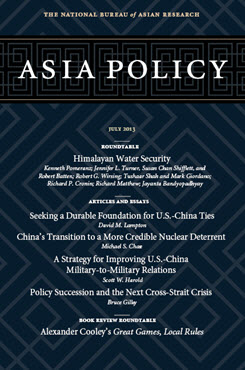Asia's Unstable Water Tower
The Politics, Economics, and Ecology of Himalayan Water Projects
This is one of seven essays in the roundtable “Himalayan Water Security: The Challenges for South and Southeast Asia.”
Asia’s ten largest rivers by volume—including the Yangtze, Mekong, Brahmaputra (which becomes part of the Ganges), and Indus—originate in the Himalayas or on the Tibetan Plateau and collectively serve 47% of the world’s population. Inadequate or unreliable water supplies pose serious and worsening problems in all the countries along these rivers, as do energy shortages. To varying degrees, these issues threaten domestic stability throughout the region, leading countries to build dams to control water flows and generate hydroelectric power. Such projects not only pose significant environmental risks but create international tension over water-sharing on transborder rivers. Furthermore, nine of Asia’s ten largest rivers begin in China, which has no water-sharing agreements with downstream countries; in some cases, the downstream countries also have no agreements with countries further downstream. Even the sharing of hydrological data is spotty. That China, as the upstream country, is increasingly capable of undertaking projects that would address its needs at the expense of its downstream neighbors makes the situation even more tense. While China has promised to be mindful of other countries’ interests, it continues to make decisions unilaterally and often secretly. Climate change, which is likely to reduce the water supply at the source of many Himalayan rivers, will only magnify these disputes and probably make any solution that guarantees specific amounts of water or parts of a joint river to specific countries unfeasible.
This essay discusses the implications of China’s dam-building projects within the Himalayan watershed, as well as one possible project that Beijing denies planning but which its neighbors fear. The next section then describes possible solutions to current and future water disputes. The essay argues that the combination of immediate problems and longer-range threats requires, at the very least, three developments. First, more must be done to share basic data, both about hydrology and about planned projects. Second, steps must be taken to institutionalize at least some cooperation in the exploitation of these rivers—either through multinational organizations or bilateral arrangements (e.g., joint ownership of hydroelectric dams). Third, all countries will need to undertake domestic efforts to manage water demand and reduce waste in ways that lessen dependence on water supplies to deal with future needs. It is particularly important that China implement these changes, since such efforts represent the best option for Beijing to credibly reassure its neighbors that it will not preempt the flow of rivers that begin in Chinese territory. Fortunately, waste reduction and recycling efforts are also likely to offer China more water security per dollar spent, and at less risk, than the mega-projects that its neighbors fear.
China, Its Neighbors, and the Implications of Dam-building
Increasingly, China’s prospects for continued economic growth are threatened by shortages of clean water and rising energy demand. The country has barely a quarter of the global per capita water supply, and decades of emphasis on raising agricultural yields by extending irrigation (often inefficiently), weak enforcement of pollution controls, and economic arrangements that fail to reward conservation have exacerbated the situation. Massive exploitation of underground aquifers since the 1950s masked these problems temporarily, but the country’s groundwater is being rapidly depleted. In addition, China, and the world, need alternatives to fossil fuel in order to power this economic growth. Descending from the world’s highest mountains, Himalayan water offers enormous, and still largely unexploited, hydropower potential.
With water and energy pressures mounting while its engineering and financing capabilities grow, it is not surprising that China is undertaking numerous water projects in Tibet and adjacent provinces: these include recent or ongoing projects on the Chinese portions of the Indus, Sutlej, Brahmaputra, Salween, Irrawaddy, and Mekong. Although China insists that none of these projects will have adverse effects on any downstream country, this is nearly impossible to ensure, even with complete transparency. Under the current circumstances, downstream countries’ anxieties continue to grow.
Lurking in the background is a possibility much more threatening than any current dam: that Beijing will eventually divert huge amounts of water from international rivers that start in Tibet to address chronic water shortages in northern China’s Yellow and Hai river basins. Such a diversion has been discussed for years. Its chief public promoter, Guo Kai, is a retired…
About Asia Policy
Asia Policy is a peer-reviewed scholarly journal presenting policy-relevant academic research on the Asia-Pacific that draws clear and concise conclusions useful to today’s policymakers. Asia Policy is published quarterly in January, April, July, and October and accepts submissions on a rolling basis. Learn more


